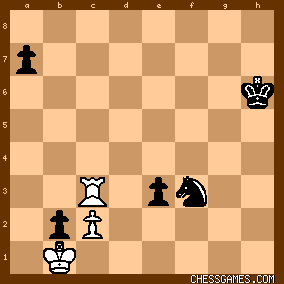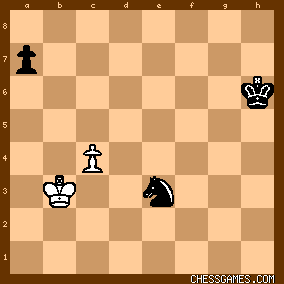Oct-23-03
 | | Sneaky: According to Nunn the losing move came as late as the last one: 69.♔a2?? a3! Now Black can force the exchange of pawns, leading to the theoretically winning ending of ♕ vs ♖. 69.♖a3! is the only move to draw. After 69...♕e5+ 70.♔a2 Black cannot make progress. White should keep his ♔ on b2 except when checked, and otherwise keep his ♖ posted on a3 or d3. (from John Nunn's Puzzle Book)
Fortresses are fascinating, aren't they? |
|
| Oct-24-03 | | drukenknight: Hey Sneaky are you sure this game is won? After 70 Rb3+.... SHOW ME YOUR WINNING LINE! |
|
Oct-24-03
 | | Honza Cervenka: 70.Rb3+ Kc4 71.Kb1 (71.Kxa3 Qxc2  ) 71...Qe1+ 72.Ka2 Qc1 73.Rc3+ (73.Rxa3 Qxc2+ ) 71...Qe1+ 72.Ka2 Qc1 73.Rc3+ (73.Rxa3 Qxc2+  ) 73...Kb4 74.Rb3+ Ka4 and black wins. ) 73...Kb4 74.Rb3+ Ka4 and black wins. |
|
| Oct-24-03 | | drukenknight: what does that little arrow mean? At least you are not using acorns for Q. |
|
| Oct-24-03 | | drukenknight: 70. Rb3+ Kc4 71. Kxa3 Qxc2 72. Rb4+ Kc5
73. Rb5+...!? |
|
Oct-24-03
 | | Honza Cervenka: <dk> Well, black cannot take the Rook but after 73...Kc6 it is only a matter of technique and time to win the ending K+Q against K+R. You can find it in any book of endings. |
|
| Oct-24-03 | | drukenknight: How do you know all K/R vs K/Q endgames are lost? Is that a firm conclusion in theory? I had asked this question a few months ago and got on reply. |
|
Oct-24-03
 | | Honza Cervenka: <How do you know all K/R vs K/Q endgames are lost?> There are some special cases where weaker side can force the draw, but usually the Queen should win against the Rook. It's pretty old theory. On the other side it is not so trivial to win this ending and so it is worth to not resign and to continue in play, especially against any weaker opponent. |
|
| Oct-24-03 | | drukenknight: YOu say there are special cases...In this ending, there is the real threat of stalemate. See me, I would think that already makes this ending pretty odd, but I guess this is not special enuf, huh? How do you know when its special? |
|
Oct-24-03
 | | Honza Cervenka: For example, one such a special case can arise from final position after 70.Rb3+ Kc4 71.Kb1 a2+ 72.Kb2 a1=Q+ (72...Qxc2+! 73.Kxc2 a1=Q  ) 73.Kxa1 Qxc2 74.Rb4+ Kd3 75.Rb3+! = (black King cannot escape from checks of white Rook via the second line for Rb2 with a pin of Queen and he cannot take the Rook for a stalemate) 75...Kc4 76.Rb4+ Kc5 77.Rb5+ Kc6 78.Rb6+ Kc7 79.Rb7+ Kc8 80.Rb8+ etc. ) 73.Kxa1 Qxc2 74.Rb4+ Kd3 75.Rb3+! = (black King cannot escape from checks of white Rook via the second line for Rb2 with a pin of Queen and he cannot take the Rook for a stalemate) 75...Kc4 76.Rb4+ Kc5 77.Rb5+ Kc6 78.Rb6+ Kc7 79.Rb7+ Kc8 80.Rb8+ etc. |
|
Oct-24-03
 | | Eggman: The special cases are basically tactical: the side with the Rook needs the move and a position like HC quotes above. Otherwise the player with the Queen maneuvers for zugzwang, the allied King and Rook are forced to separate so that the former cannot protect the latter, and then Queen forks and threats of mate decide the issue. |
|
Nov-05-03
 | | Eggman: <what does that little arrow mean?> DK, the  is not supposed to be an arrow, it's just a symbol (a subtraction sign followed by an addition sign) indicating that Black has a winning advantage, whereas is not supposed to be an arrow, it's just a symbol (a subtraction sign followed by an addition sign) indicating that Black has a winning advantage, whereas  would indicate that White has a winning advantage. would indicate that White has a winning advantage. |
|
Nov-05-03
 | | Eggman: <it is not so trivial to win this ending <Q vs R> and so it is worth it to not resign and to continue in play, especially against any weaker opponent> In fact, in the 6th game of their 1983 Candidates semi-final match (Korchnoi vs Kasparov, 1983) Korchnoi and Kasparov reached this ending, with Korchnoi playing on for a further 9 moves before resigning (and raising some eyebrows in the process). |
|
Nov-05-03
 | | Eggman: If I can state more explicitly the case of K+Q vs K+R: if you have the Queen and it is your move, then you can always win provided that you are not currently in check and provided that your Queen is not currently pinned to your King. |
|
| Nov-12-12 | | vinidivici: I will answer some of the questions above.
<How do you know all K/R vs K/Q endgames are lost? Is that a firm conclusion in theory?> K+R+pawns v K+Q+PASSED pawns is
90% K+Q+PassesdPawn would win BUT theres a kind of position that will draw just like the position above after move 68. 69.Ka2 ??? is the death move
69.Ra3!!!!!!!!!!!!! DRAW.
<drukenknight: YOu say there are special cases...In this ending, there is the real threat of stalemate.How do you know when its special?>
YES, the ending above esp after move 68 is a special case for the particular ending. It has a DRAW chance. How do you know its special? There is only one answer: STUDY. then you will know. < If I can state more explicitly the case of K+Q vs K+R: if you have the Queen and it is your move, then you can always win >
True. But the calculations change with involving pawns. After 69.Ra3!! and queens side to move still draw. |
|
| Jul-19-20 | | nummerzwei: So far, the Q vs R endgame and Timman's blunder in it have gotten all the attention. It's worth pointing out that there was no need to go for it in the first place: 
click for larger viewWhite has a choice of which pawn to capture. Timman went for the fortress with 54.Kxb2, but he could also have drawn with 54.Rxe3 Nd2+ 55.Kxb2 Nc4+ 56. Kb3 Nxe3 57.c4! 
click for larger viewe.g. 57...Nf5 58.Kb4 Ne7 59.Kb5 Kg6 60.Ka6 Nc6 61.c5 Kf7 62.Kb7 a5 63.Kxc6 a4 64.Kb7 a3 65.c6 = It's hard to say which line is more practical - especially since the Q vs R fortress is well-known endgame theory. It'd be interesting to know on which moves the game was adjourned, and how much time Timman had left at the end. |
|





